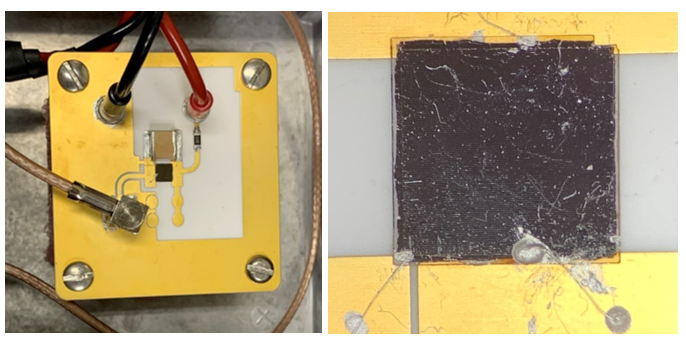
Multi-Layered Avalanche Diamond Detector for Fast Neutron Applications

Project #: 22-024 | Year 3 of 3
Amber Guckes,a Rob Buckles,a Adam Wolverton,a J. Andrew Green,a Charles Han,b Kaleab Ayalewa,b
aNevada National Security Site (NNSS); bUniversity of Nevada, Las Vegas
Executive Summary
The primary goal of this project was to design and fabricate a novel multi‐layered avalanche diamond (MAD) detector leveraging the intrinsic avalanche and atomic properties of single-crystal chemical vapor deposition (scCVD) diamond to yield a novel fast neutron detector with inherent gain, improved detection efficiency compared to a single layer, and a small footprint. A series of calculations, simulations, and single-layer thin scCVD diamond detector measurements were performed to inform the MAD detector design. The data gleaned from these efforts ultimately led to the design and fabrication of two MAD detectors: one based on the transport of electrons through vertically stacked diamond layers and the other based on the horizontal transport of electrons through the bulk of a single diamond layer.
Description
A significant amount of the third and final year of funding by the NNSS SDRD program for the MAD detector project was spent iterating on the MAD detector design as Applied Diamond, Inc., our collaborator and subcontractor, performing the fabrication of the diamond, was confronted with anticipated challenges. Overcoming these challenges was a huge success in and of itself. The project culminated in the receipt of the very first horizontal and vertical MAD detector prototypes.

Conclusion
The prototype MAD detectors were received within the last two weeks of the fiscal year leaving no time to perform characterization measurements to confirm charge multiplication in the devices or to ascertain their gain. Fortunately, the MAD detector work will continue on in FY23 under the funding of the NNSS Detectors and Instrumentation project. The team will be characterizing these prototypes in the first few weeks of FY23 and aims to improve upon the MAD detector design conceived under the SDRD program over the past three years.
Mission Benefit
The Neutron Diagnosed Subcritical Experiment (NDSE) program at the NNSS requires an in-beam diagnostic to accurately measure a pulse of neutrons from a dense plasma focus (DPF). The MAD detector can be deployed as an in-beam detector and provide improved performance that would drive down the uncertainties of the DPF source term measurement and ultimately the uncertainties in the calculation of Δkeff of the object being interrogated by the DPF neutrons. This is of critical importance to NDSE. The MAD detector will be fielded as part of an NDSE static campaign in FY23.
Publications, Technology Abstracts, Presentations/Posters
Green, J. A., A. Guckes, R. Buckles, D. Constantino, J. Friedman, J. Tabeling, A. Wolverton. 2020. “Geant4 and MCNP6.2 modeling of fast-neutron detectors based on single-crystal chemical vapor deposition diamond.” InProc. SPIE 11494, Hard X-Ray, Gamma-Ray, and Neutron Detector Physics XXII, 1149417. Poster presented at SPIE Optical Engineering + Applications Conference, online. https://doi.org/10.1117/12.2567750.
Guckes, A., R. Buckles, A. Wolverton, I. Garza, J. A. Green, J. Tabeling. 2021. “Direct current response of a thin scCVD diamond detector under increased applied field to 14.1 MeV neutrons.” InProc. SPIE 11838, Hard X-Ray, Gamma-Ray, and Neutron Detector Physics XXIII, 1183814. Presentation presented at SPIE Optical Engineering + Applications Conference, San Diego, CA. https://doi.org/10.1117/12.2593455.
Guckes, A., R. Buckles, J. A. Green, A. Wolverton. 2020. “Multi‐layered avalanche diamond detector for fast neutron applications.” Mission Support and Test Services Technology Abstract (10 June 2020).
This work was done by Mission Support and Test Services, LLC, under Contract No. DE-NA0003624 with the U.S. Department of Energy. DOE/NV/03624–1599.
Return to Neutron Technologies and Measurements
Go to SDRD Annual Report Index
Return to SDRD Homepage
